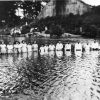calsfoundation@cals.org
Albert Krantz v. City of Fort Smith
aka: Krantz v. City of Fort Smith
Albert Krantz v. City of Fort Smith was a 1998 decision by the Eighth Circuit Court of Appeals concerning the distribution and posting of flyers and leaflets. In a ruling informed by the First Amendment’s protection of freedom of expression, the Court of Appeals deemed unconstitutional town ordinances enacted by Alma (Crawford County), Dyer (Crawford County), Fort Smith (Sebastian County), and Van Buren (Crawford County) prohibiting the leafletting of vehicles parked in public spaces.
The case originated with the arrests of Albert Krantz and other members of the Twentieth Century Holiness Tabernacle Church after they left religious leaflets under the windshield wipers of vehicles parked in public parking areas in Alma, Dyer, Fort Smith, and Van Buren in the early part of 1995. In the trial in the district court, Krantz and his fellow defendants were found guilty of a violation of a local ordinance that prohibited the placing of a handbill or an advertisement on a person’s vehicle parked on public property within the city limits unless the vehicle’s owner was willing to accept the item. In June 1995, the accused appealed their convictions, believing that the ordinances violated their First Amendment rights. In addition, they argued that their arrest reflected selective enforcement of the ordinance by local law enforcement officials and that the initial enactment of the law had been discriminatory.
After first dispatching some issues related to the appellants’ standing to bring the challenge, the appeals court began its consideration of the convictions by addressing the nature of the regulations themselves as well as their impact. In doing so, the appeals court came to a conclusion very different from that of the district court. While the district court had acknowledged that the ordinance could be seen as a limitation on free expression, it saw that as only a secondary issue. Applying a public forum test to the ordinance, the district court determined that the ordinance was content neutral as well as sufficiently narrow to achieve its greater goal. The district court believed that the primary issue involved in the case was the local governments’ efforts to prevent littering in public spaces; the cities argued that this was a regular occurrence since the physical act of removing the handbill from a windshield was almost inevitably followed by its “deposit” on the ground. In the district court’s view, the prevention of such littering was not just a wholly legitimate governmental interest, one that justified such regulation, but was also the predominant issue in the case.
In contrast, while the Court of Appeals did not dispute the legitimate governmental purpose involved in preventing littering, it noted that, as laudable as its goal may have been, the ordinance was not sufficiently narrow in its focus, having an impact beyond simply reducing litter. Rather, the overly broad aspect of the ordinance meant that it also impacted the freedom of expression. As the Court of Appeals stated, “The ordinances suppress considerably more speech than is necessary to serve the stated governmental purpose of preventing litter.” Again, the appeals court did not dismiss the legitimacy of the municipalities’ interest in preventing littering, but it did note that the cities had the ability to punish those who litter after they have in fact done so. To support this interpretation, the Appeals Court cited a 1943 decision of the U.S. Supreme Court that had asserted that the “goal of preventing littering can be accomplished by punishing…the ‘litterbugs’ who choose to throw the papers on the ground.”
In the end, the appeals court said that the ordinance, as written, was a violation of the First Amendment because it was overbroad in the restrictions it imposed on free speech. In making that determination, the court noted that it need not address the issues of selective enforcement or the matter of whether the initial enactment had been discriminatory.
Unhappy with the ruling of the Court of Appeals, the cities of Fort Smith, Alma, and Dyer appealed their case to the U.S. Supreme Court. However, that body denied certiorari (an order by which a higher court reviews a lower court’s decision) on June 24, 1999.
Once they had secured a victory on the merits, Krantz and his fellow litigants returned to court in an effort to turn the case into a class-action suit. This subsequent effort was unsuccessful, and the case’s historical legacy was limited to its impact on First Amendment jurisprudence.
For additional information:
Kenworthy, Bill. “Fliers & leafletting.” First Amendment Center, September 28, 2007. http://www.firstamendmentcenter.org/fliers-leafleting (accessed September 22, 2020).
Krantz v. City of Fort Smith (1998). http://caselaw.findlaw.com/us-8th-circuit/1381522.html (accessed September 22, 2020).
Rubin, Nicole. “Cars as an Appropriate Vehicle for Communication? Exploring ‘The Short, Though Regular, Journey’ from the Windshield to the Pavement.” Journal of Civil Rights and Economic Development 26 (Winter 2012): 449–477. Online at http://scholarship.law.stjohns.edu/cgi/viewcontent.cgi?article=1706&context=jcred (accessed September 22, 2020).
William H. Pruden III
Ravenscroft School
 Divergent Prosperity and the Arc of Reform, 1968–2022
Divergent Prosperity and the Arc of Reform, 1968–2022 Law
Law Religion
Religion




Comments
No comments on this entry yet.